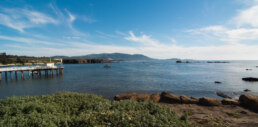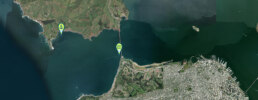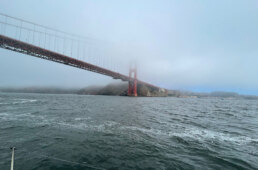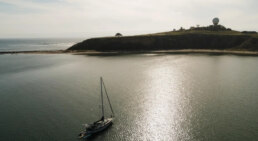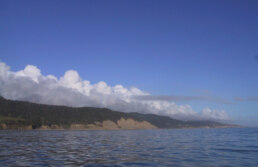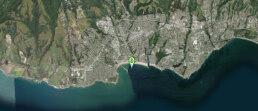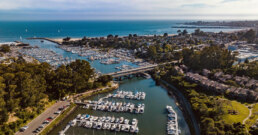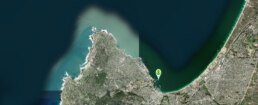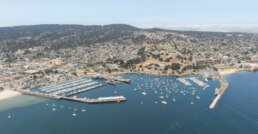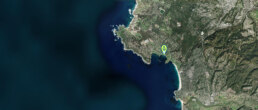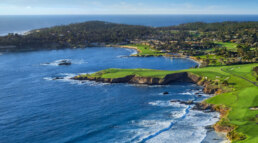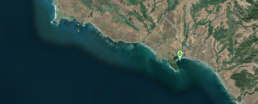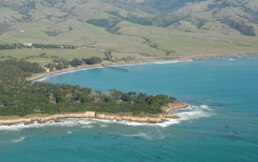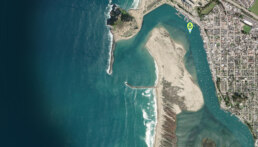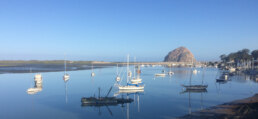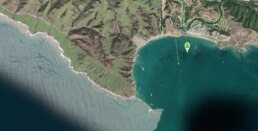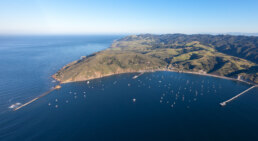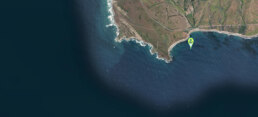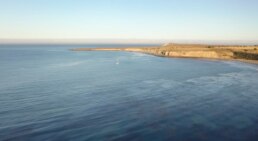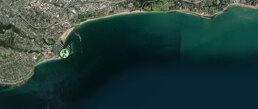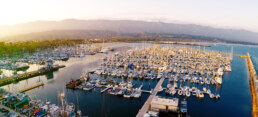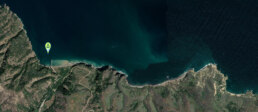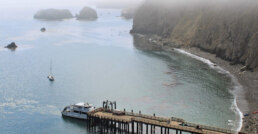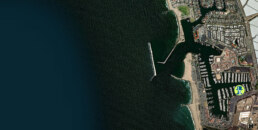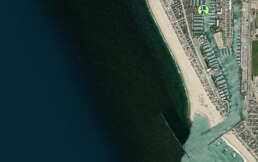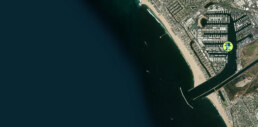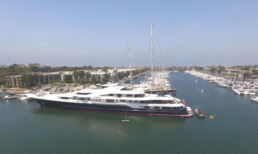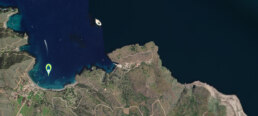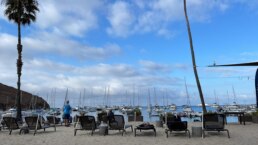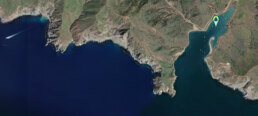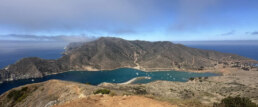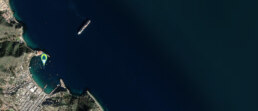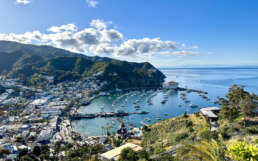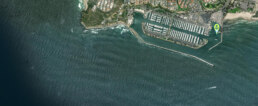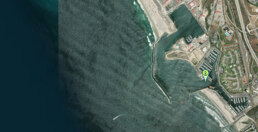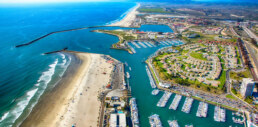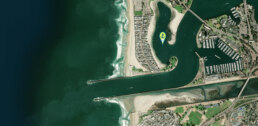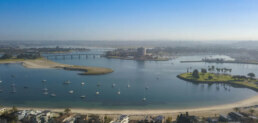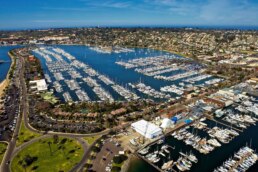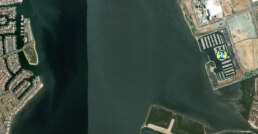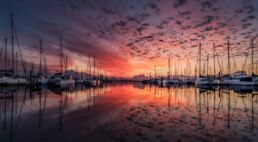SAN FRANCISCO TO SAN DIEGO 550 NM MILES OF DOWNWIND BLISS
🧭 NORTH TO SOUTH: SAN FRANCISCO TO SAN DIEGO MAIN ANCHORAGES 550 nm
Sailing south from San Francisco to San Diego in August and September offers a generally begning blend of Pacific weather systems. August often starts with persistent coastal fog—especially north of Point Conception—where cold water and inland heat create dense marine layers that can reduce visibility to near zero. Radar and AIS and listening for northbound ships become essential tools during these stretches.
Rain is rare this time of year, but drizzle from fog can soak sails and decks. As you move further south, the fog generally thins, giving way to sunny skies and warmer air, particularly past Point Conception. That point itself marks a climatic boundary north of it, the California Current drives cool, moist air; south of it, conditions trend warmer, drier, and more stable.
Wind is typically out of the northwest, 10 to 25 knots, building in the afternoons. Mornings can be calm, and sailing is often best timed to take advantage of the early light air or ride the afternoon push. Swells also come predominantly from the northwest, ranging from gentle rollers to short-period chop, especially near points and capes.
Santa Ana winds do not develop till later those are hot, dry offshore blasts, can make rare early appearances in late September. If they arrive, expect dramatic shifts in wind direction and velocity, especially near Southern California’s coastal valleys. These winds can turn calm anchorages into lee shores and should be watched closely especially vessels anchoring in the Channel Islands or on moorings off Catalina Islands.
Whales, particularly humpbacks and blue whales, are often spotted during this run. Summer and early fall bring krill and baitfish to the surface, and large cetaceans follow. Keep a keen lookout, collisions are rare but possible.
Overall, this stretch of coast offers a steady downwind ride, moderated by marine layers and punctuated with wildlife. It’s a great time to sail south, just keep one hand on the helm and one eye on the barometer.
Leaving at the wrong time from Morro Bay during an August or September southbound passage can have serious consequences, especially when it comes to swell. The entrance to Morro Bay is narrow, shifting, and fully exposed to swell. It was build by the Army core of Engineers. While conditions inside the harbor are mostly calm, the bar at the entrance can turn treacherous quickly, especially after mid-morning when wind-driven swell builds.
Look for the little otters in the bay.
If you miss the early departure window, the combination of rising tide and onshore breeze can stack swell right on the entrance, creating a breaking bar. Even modest swell, 4 to 6 feet at 10 seconds, can make it feel like you’re surfing through a washing machine. Larger swells or long-period waves can close out the entrance entirely, effectively locking boats inside for hours or even days.
Local warnings are often issued when the bar is breaking, and the Coast Guard may restrict departures. Timing is everything. Ideally, depart just after first light on a falling tide with minimal swell, before the wind picks up. Swell direction is key—anything west or northwest funnels directly in. Southern swell is less of a threat but still needs watching.
If you’re stuck inside, be patient. Use the downtime to top off fuel, re provision, or take on water. But resist the temptation to “punch through” a questionable entrance—many a skipper has regretted that decision.
Planning around swell windows is essential all along the California coast, but Morro Bay is one of the spots where getting it wrong can cost you more than just time
Sailing Out of San Francisco Bay
The Golden Gate is a narrow and dynamic gateway to the Pacific, funneled by tides, fog, and swell. Outbound passages are often against strong ebb currents that can exceed 4 knots, especially during spring tides. Combine this with a Pacific westerly swell and an incoming breeze, and the result is a sharp, confused sea known locally as “potato patch” conditions.
Fog and Visibility:
Fog is frequent from late spring through early fall, often hugging the coast and rolling in thick during the afternoon. Visibility can drop to near zero beyond Mile Rock or Point Bonita. Radar, AIS, and a sharp lookout are essential.
Wind:
The famous “Slot Effect” produces strong west-northwest winds that funnel through the Gate. Afternoon winds in summer typically build to 20-30 knots with gusts higher, especially off Angel Island and around Alcatraz.
Timing Your Exit:
The best time to sail out is during slack tide or the beginning of a flood to avoid standing waves and turbulence. Early morning departures offer lighter winds and reduced fog in some seasons.
Sea Life and Traffic:
Expect to encounter humpback whales, harbor porpoises, and large container ships. Stay outside the Traffic Separation Scheme lanes when possible and monitor VHF 13 and 14 for commercial traffic near the Gate.
1. Half Moon Bay – Pillar Point Harbor ( 24 nm Golden Gate Bridge – Half Moon Bay )
• Location: 037° 29.8401′ N 122° 29.2901′ W
• Notes: Good first stop outside the Golden Gate. Anchoring near the outer harbor is common, though swell can wrap around. Pillar Point Harbor has guest docks and fuel dock if needed.
2. Ano Nuevo Bay – ( 32 nm Half Moon Bay – Ano Nuevo Bay )
Location : 37° 06.4809′ N 122° 18.9732′ W
Can be very rolly – anchor in Settled Conditions 22 feet
5. Santa Cruz
• Location: 36°57.050’N 122°00.910’W
• Notes: Open roadstead with decent holding, often rolly unless the swell is down. Good for a brief overnight in settled weather.
6. Monterey Bay (Monterey Harbor)
• Location: 36° 36.2509′ N 121° 53.1927′ W
• Notes: Well-protected marina with some space to anchor outside. Popular with cruisers. Watch for kelp beds. decent beach landing and marina access by dinghy.
7. Stillwater Cove @ Pebble Beach
• Location: 36° 33.8651′ N 121° 56.4919′ W
• Notes: Beautiful but exposed anchorage. Only suitable in very calm weather. Kelp can make anchoring tricky. Surrounded by Pebble Beach golf course to the east and north, Anchoring allowed to the east of the mooring balls. When the harbor “closes” after Labor Day Weekend, anchoring within the mooring ball field is allowed. 10’-12’ at low tide. Can dinghy to the beach.
8. San Simeon Bay
• Location: 35° 38.3781’N 121° 11.5271′ W ~ 25′
• Notes: A fair-weather anchorage with some protection from NW swell. Good rest point between Monterey and Morro Bay.Stay 1/2 nm off San Simeon Point when entering as there is a kelp bed
9. Morro Bay – wait for weather window to get around point Conception
• Location: 35°22.0625’N 120° 51.3813′ W
• Notes: Protected and popular stop. Narrow entrance channel with breaking waves in swell—check bar conditions. Good anchoring in the estuary. Wait for Weather window
10 Port San Luis (Avila Beach)
• Location: 35° 10.3471 ‘N 120° 44.2539’ W
• Notes: Wide open bay with many moorings between the westerly and the middle pier. and good anchorage in settled weather. Swell can make it uncomfortable.Protected anchorage Another spot to wait for weather windows around Point Conception.
11. Cojo Anchorage (Point Conception)
• Location: 34°27.300’N 120°27.600’W
• Notes: Crucial staging anchorage for rounding Point Conception. Sheltered in NW winds but exposed to south. Anchor behind the point in sandy bottom.
12. Santa Barbara marina has transient slips up to 2 weeks
• Location: 34°24.550’N 119°41.900’W
• Notes: You can anchor outside the breakwater or go into the marina. Good protection and amenities.
Channel Islands
• Key Spots:
13. Prisoners Harbor (Santa Cruz Island) – 34°01.230’N 119°41.770’W
14. Smugglers Cove (Santa Cruz Island) – 33°59.700’N 119°29.800’W
15. Scorpion Anchorage – exposed but beautiful
• Notes: National Park territory with rugged anchorages. Worth detouring for if weather permits.
16. Safe Harbor Ventura Isle
• Location: 34° 14.7′ N 119° 15.595′ W
• Notes: Full-service marinas with limited anchoring. Protected
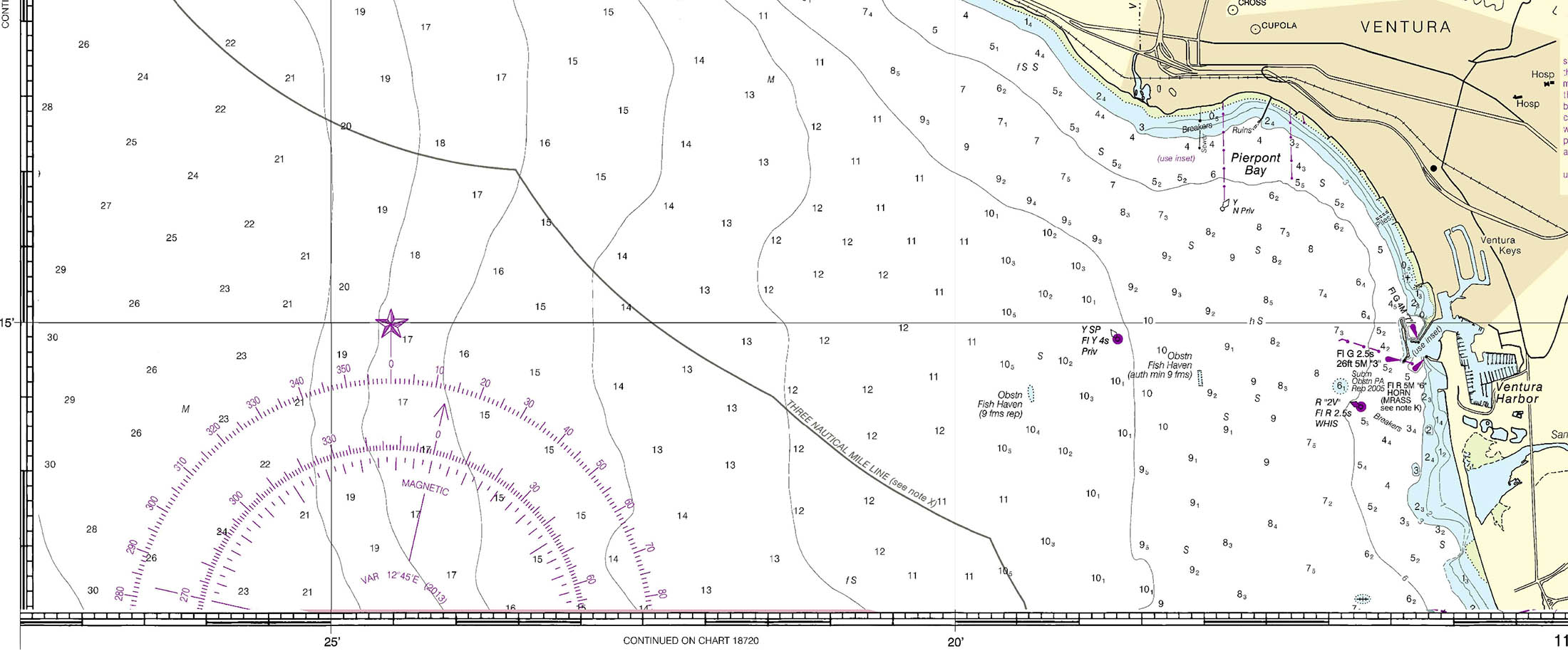
17) VINATGE MARINA
• Location:34° 10.2466′ N 119° 13.6883′ W
• Notes: Full-service marinas with limited anchoring. Protected
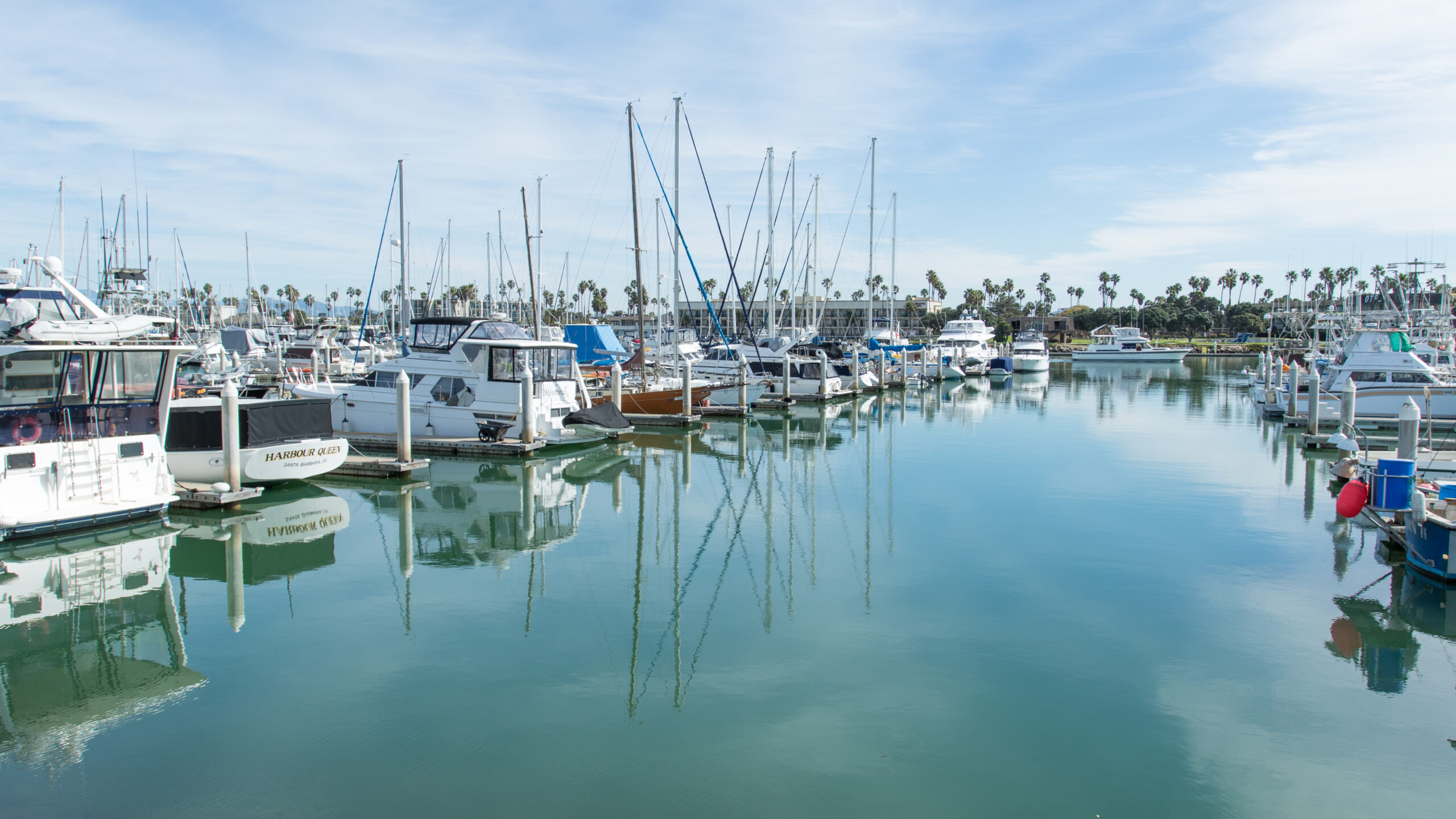
18. Marina del Rey – easy dock access to Trader Joe’s
• Location: 33°58.700’N 118°27.400’W
• Notes: Mostly marina slips, but limited anchoring space in the basin. Good provisioning stop.
Catalina Island (Highly Recommended)
19. Two Harbors (Isthmus Cove) –33°26’34.9″N 118°29’45.4″W : Mooring balls only or anchor in nearby coves ( up to 70′ deep )
Catalina Island
20. Cat Harbor back side of Catalina Island in case of a Santa Ana wind 33°25’56.9″N 118°30’17.1″W
Catalina Island
21. Avalon Harbor – 33°20’48.5″N 118°19’29.3″W : Mooring balls BUSY PORT TOURIST PORT
22. Dana Point Harbor
Location 33°27’31.5″N 117°41’26.6″W
Several Marinas and a breakwater
23. Oceanside Harbor
• Location: 33°12’29.9″N 117°23’48.4″W
• Notes: Limited guest space and anchoring. Good weather stop if space allows.
24. Mariners Basin – Mission Bay – San Diego North
Location 32°45.81′ N 117°14.865′ W
25. San Diego Bay Shelter Island
• Location: 32.716231, -117.230849
• Notes: Limited anchorage in Shelter bay 10 day limit
26. Safe Harbor South Bay
• Location: 32°37’17.9″N 117°06’07.6″W
• Every October we have the Cruising Seminars here in October
https://oceanposse.com/events/san-diego-seminar-series/

GREECE 🇬🇷 CRUISING WITH THE OCEAN POSSE
 Greece is one of the most diverse cruising grounds in the Mediterranean, with distinct regions offering different sailing conditions, cultural highlights, and marina infrastructure.
Greece is one of the most diverse cruising grounds in the Mediterranean, with distinct regions offering different sailing conditions, cultural highlights, and marina infrastructure.
The ideal sailing window runs from May through October, with each month offering distinct pros and cons.
May and June bring warm but not scorching temperatures, fewer tourists, and mild seas—perfect for those seeking quieter anchorages and a balance of adventure and serenity. The winds are generally moderate, with the Meltemi not yet in full force. Wildflowers still linger in the islands, and the water is beginning to warm up for swimming.
July and August are peak season. Expect hot days, bustling tavernas, and crowded ports—especially in hotspots like Mykonos or Santorini. The Meltemi, a strong north wind, dominates the Aegean during this period, blowing steadily and sometimes fiercely. It can make passages challenging, particularly on east-west routes in the Cyclades. For experienced skippers, it’s a fast downwind ride; for novices, a test of seamanship.
September is a sweet spot—sea temperatures are at their warmest, the crowds begin to thin, and the Meltemi starts to ease. Ports become more relaxed and provisioning simpler. Many sailors consider it the best month overall for Greek cruising.
October is the tail end of the season. Weather remains pleasant in the south, particularly the Dodecanese and Crete. Winds shift to become more southerly and unpredictable. Some marinas and facilities begin to close, but this can be a bonus for solitude seekers.
From November to April, most leisure sailing ceases due to stormier weather, cooler temps, and many marinas reducing services. However, hardy liveaboards still cruise during winter, especially in protected zones like the Ionian.
Here are the main cruising regions in Greece:
1. Ionian Islands (West Coast of Greece)
• Main Ports: Corfu, Lefkada, Kefalonia, Zakynthos, Ithaca
• Known for: Calm seas, predictable winds, green landscapes, family-friendly cruising
• Best for: Beginners, relaxed sailing, anchoring in protected bays
2. Peloponnese & Mainland West Coast
• Main Ports: Patras, Katakolon, Pylos, Gythio, Kalamata
• Known for: Historic ruins, rugged coastlines, fewer crowds, traditional villages
• Best for: Cultural exploration, off-the-beaten-path cruising
3. Saronic Gulf & Athens Area
• Main Ports: Athens (Alimos, Zea), Aegina, Poros, Hydra, Ermioni
• Known for: Short passages, proximity to Athens airport, year-round marinas
• Best for: Easy week-long charters, shoulder season sailing, cultural sightseeing
4. Cyclades Islands (Central Aegean)
• Main Ports: Syros, Paros, Naxos, Mykonos, Santorini
• Known for: Iconic white-washed towns, strong Meltemi winds, open-sea passages
• Best for: Experienced sailors, classic Greek postcard views, nightlife + adventure
5. Dodecanese Islands (East Aegean, near Turkey)
• Main Ports: Rhodes, Kos, Symi, Patmos, Kalymnos
• Known for: Blend of Greek & Ottoman heritage, reliable wind, well-equipped marinas
• Best for: Island-hopping, longer passages, cultural variety
6. North Aegean & Sporades Islands
• Main Ports: Volos, Skiathos, Skopelos, Lesvos, Thassos
• Known for: Pine forests, mountainous terrain, fewer charter fleets
• Best for: Mixed sailing skill levels, nature, and hidden anchorages
7. Crete
• Main Ports: Chania, Rethymno, Heraklion, Agios Nikolaos
• Known for: Large island with strong winds, deep culture, and distance from mainland
• Best for: Explorers on longer passages or ferries; challenging for short-term charters
MARINAS
WEATHER
WINDS
Tides and Currents
SWELL AND WAVES
PILOT CHARTS
GREECE Pilot Charts provide historic points and aggregated information of wind flows, air and ocean temperatures, wave heights, rain, barometric weight, and climate conditions at various seasons. This data was acquired from oceanographic and meteorologic perceptions over hundreds of years starting in the late eighteenth century. These diagrams are planned to help mariners choose routes around and approaching GREECE with respect to the normal climate and sea conditions using prevailing seasonal wind information.

PORTS OF ENTRY
⚓Northern Greece Yacht Entry Ports
1 Thessaloniki
◦ Major maritime gateway in Northern Greece with full customs, immigration, port police-all essential clearance services
2 Kavala
◦ Eastern Macedonia, key sea port offering formalities; included in national ports list .
3 Alexandroupoli
◦ Near Turkish border, customs-equipped major port
4 Igoumenitsa
◦ In Epirus (northwest coast), a primary PoE and international ferry port; equipped for yacht clearance .
5 Keramoti
◦ Included among Greece’s maritime ports with customs/immigration presence
6 Thasos (Limenas)
◦ Island port on northern Aegean; listed among passenger ports-customs/immigration assumed available .
⚓ Ionian Islands – Ports of Entry for Yachts
1 Corfu (Kerkyra)
◦ Main entry port for the northern Ionian
◦ Clearance available at the Port Authority and Customs Office
◦ Gouvia Marina nearby with agent services
2 Paxos (Gaios)
◦ Smaller PoE
◦ Port police and limited customs services available seasonally
3 Lefkada (Lefkas Town)
◦ Floating bridge allows access to the Lefkas Canal
◦ Port police and customs in town
4 Preveza
◦ Technically on the mainland but part of the Ionian cruising circuit
◦ Several marinas (Cleopatra, Aktio, Preveza Marina) support clearance
5 Ithaca (Vathy)
◦ Official PoE, though limited facilities—often used for formal exit or seasonal check-ins
6 Kefalonia (Argostoli)
◦ Major clearance port on the island
◦ Customs and port police near the main ferry dock
◦ Sami (on the east coast) also supports clearance in peak season
7 Zakynthos (Zante)
◦ Official PoE with full clearance services
◦ Port police and customs located near the ferry terminal
⚓ Peloponnese & Mainland West Coast – Ports of Entry
1 Patras
◦ Major ferry and commercial port
◦ Full customs, immigration, and port authority services
◦ Very active for both inbound and outbound yacht clearances
2 Kyllini
◦ West Peloponnese
◦ Smaller port with seasonal customs and police services
◦ Often used for ferries to the Ionian islands
3 Katakolon (near Olympia)
◦ Cruise ship destination, also serves private yachts
◦ Customs and port police are available
4 Pylos (Navarino)
◦ Sheltered bay with customs and port police
◦ Nearby marina (Navarino Marina) offers good infrastructure
5 Kalamata
◦ Southern Peloponnese, full port of entry
◦ Marina Kalamata has customs and port police on site
6 Gytheio (Gythio)
◦ Southeastern Peloponnese
◦ Customs and port police available, used for Aegean-Mediterranean crossings
7 Neapoli Voion
◦ Near Cape Maleas
◦ Smaller port of entry, often used by yachts rounding the Peloponnese
8 Igoumenitsa (mainland northwest, often grouped with west coast)
◦ Major port near the Albanian border
◦ Full clearance available
⚓ Athens Area & Saronic Gulf – Yacht Ports of Entry
1 Piraeus
◦ Main commercial port of Athens
◦ Full customs, immigration, and port police presence
◦ Can be bureaucratic and busy but comprehensive
2 Alimos Marina (Kalamaki, Athens)
◦ One of the largest marinas in Greece
◦ Official clearance handled via nearby Piraeus or on-site agents
3 Flisvos Marina
◦ High-end yacht marina near central Athens
◦ Formalities typically coordinated via customs and port police in Piraeus
4 Lavrion (Lavrio)
◦ Southeastern Attica, near Cape Sounion
◦ Full PoE with nearby Olympic Marina
◦ Popular for charter turnover and Turkish-bound traffic
5 Elefsina (Eleusis)
◦ Industrial port northwest of Athens
◦ Less commonly used by private yachts but has full clearance facilities
6 Aegina (Aigina)
◦ Closest island to Athens in the Saronic Gulf
◦ Port police present, seasonal customs formalities possible
7 Poros
◦ Active PoE, especially for yachts heading to/from the Peloponnese
◦ Customs and port authority in town
8 Hydra (seasonal and limited)
◦ No private vehicles, tight mooring, but seasonal clearance may be available via agent
9 Ermioni (occasionally used)
◦ Not a primary PoE but sometimes used in coordination with Poros or Hydra formalities
⚓ Cyclades Islands – Official Ports of Entry for Yachts
1 Syros (Ermoupoli)
◦ Capital of the Cyclades and administrative hub
◦ Full customs, immigration, and port authority services
◦ Reliable year-round clearance
2 Mykonos (Tourlos Port)
◦ Busy seasonal PoE, especially in summer
◦ Customs and immigration near the new port
◦ Expect congestion and can be subject to strong winds (meltemi)
3 Naxos
◦ Well-developed port town
◦ Port police and customs office available
◦ Common PoE for east-west Cyclades routing
4 Paros (Parikia)
◦ Main ferry and yacht port on the island
◦ Port police present; customs services often available in season
◦ Naoussa is not a PoE but nearby
5 Santorini (Thira – Athinios Port)
◦ Challenging for yachts to berth; customs often requires using a local agent
◦ Formalities are available but can be logistically tricky
6 Ios
◦ Seasonal PoE
◦ Port police and customs available during peak months
7 Andros (Gavrio Port)
◦ Northernmost major Cycladic island
◦ Port authority and customs generally available
8 Tinos (limited)
◦ Can be used as a PoE, but not consistently staffed
◦ Best to verify in advance or clear through Syros or Mykonos
⚓ Dodecanese Islands – Ports of Entry for Yachts
1 Rhodes (Rodos – Commercial Port & Mandraki)
◦ Major PoE with large yacht traffic
◦ Full-time customs, immigration, and port authority
◦ Mandraki Marina and Rhodes Marina serve visiting yachts
2 Kos (Kos Town Port)
◦ Very active PoE, especially for yachts arriving from Bodrum, Turkey
◦ Customs, immigration, and port police are co-located
◦ Kos Marina also supports formalities
3 Leros (Lakki Port)
◦ Reliable PoE, especially for yachts from Didim or Kusadasi
◦ Customs and immigration near the ferry dock
◦ Leros Marina and Evros Marina both nearby
4 Kalymnos (Pothia Port)
◦ Recognized PoE with customs and police
◦ Can be busy during sponge diving and ferry arrivals
◦ Seasonal yacht traffic
5 Symi (Yialos / Simi Town)
◦ Popular and picturesque entry port
◦ Customs and immigration located near the quay
◦ Frequent check-ins from Datça, Turkey
6 Tilos (Livadia Port) (limited)
◦ Sometimes used as a PoE, but services not always staffed
◦ Best to confirm availability in advance
7 Nisyros (Mandraki) (seasonal/limited)
◦ Small but officially recognized PoE
◦ Port police and customs may not be staffed year-round
8 Kastellorizo (Megisti / Meis)
◦ Easternmost Greek island, directly opposite Kaş, Turkey
◦ Official PoE with customs and immigration
◦ Small harbor, limited dock space
⚓ North Aegean Islands – Ports of Entry for Yachts
1 Lesvos (Mytilene)
◦ Major PoE and administrative center of the North Aegean
◦ Full customs, immigration, and port authority
◦ Mytilene Marina also offers clearance support
◦ Popular with yachts arriving from Ayvalık or Dikili, Turkey
2 Chios (Chios Town)
◦ Active entry port with full clearance facilities
◦ Located opposite Çeşme, Turkey
◦ Port authority and customs offices near the ferry terminal
3 Samos (Vathi & Pythagoreio)
◦ Two recognized PoEs on the island
▪ Vathi (Samos Town): Year-round customs and port police
▪ Pythagoreio: Seasonal but commonly used by yachts arriving from Kuşadası
◦ Well organized for inbound traffic from Turkey
4 Ikaria (Agios Kirykos) (seasonal/limited)
◦ Smaller PoE, not always fully staffed
◦ Best to confirm clearance capability in advance
5 Limnos (Myrina Port)
◦ Official PoE in the northeastern Aegean
◦ Customs and immigration available for yachts arriving from Turkey or the Dardanelles
6 Thasos (Limenas Port)
◦ Northernmost island PoE, near Kavala
◦ Port police and customs generally available during the yachting season
⚓ Crete – Ports of Entry for Yachts
1 Heraklion (Iraklio)
◦ Main commercial and administrative port of Crete
◦ Full-time customs, immigration, and port police
◦ Mandraki Yacht Harbor and Heraklion Marina nearby
2 Chania (Souda Bay)
◦ Port of entry located at Souda, just east of Chania town
◦ Customs and immigration offices in the ferry terminal area
◦ Clearance sometimes coordinated via Chania Port Authority
3 Agios Nikolaos
◦ Marina-based PoE on the northeastern coast
◦ Customs and port police within walking distance of the marina
◦ Convenient for yachts arriving from the Dodecanese or Egypt
4 Sitia
◦ Easternmost port on Crete
◦ Official PoE with customs and immigration present
◦ Often used by yachts arriving from the Levant or Cyprus
5 Rethymno (limited)
◦ Smaller port with customs and port authority
◦ Services available seasonally or by arrangement
◦ Check-in/check-out sometimes requires coordination with Heraklion
DOCUMENTS
⚓ Mandatory Yacht Documents for Greece
1. Certificate of Registry (Ship’s Papers)
• Proof of ownership and nationality of the vessel.
• Must be the original document (not a copy).
2. Insurance Certificate
• Must show valid third-party liability coverage for Greek/EU waters.
• Minimum recommended coverage: €500,000 – though marinas and port police may request to see the exact value.
3. DEKPA (ΔΕΚΠΑ) – Cruising Log
• For non-commercial yachts under 24 meters.
• Issued by Port Authority (one-time fee).
• Must be stamped on each port arrival and departure unless you have TEPAI.
• Some regions now phase this out in favor of TEPAI, but some harbormasters still expect it.
4. TEPAI – Greek Cruising Tax
• Paid online at www.aade.gr.
• Required for all yachts over 7 meters in Greek waters.
• Must be paid before arrival in Greek waters or immediately upon arrival.
• Proof of payment (printed or digital) must be onboard.
5. Transit Log (for Non-EU Flagged Yachts)
• Issued by Greek Customs on arrival.
• Required for non-EU flagged yachts.
• Must be returned upon final departure from Greece.
• Often valid for 6 months (extensions possible).
6. Crew List
• Must include all persons aboard, with passport numbers and roles (captain, crew, guests).
• Submit on arrival at Port Authority or online via gov.gr if required.
7. Passports/ID for All Crew
• Valid passports (or EU national IDs).
• Schengen visa if required for non-EU nationals.
8. Skipper’s Qualifications
• For sailing yachts, ICC (International Certificate of Competence) or RYA Day Skipper or higher is accepted.
• A second competent crew member may be required (some authorities may ask for their certification too).
🧭 Additional Notes
• AIS (Automatic Identification System): Must be operational and transmitting (mandatory above certain size thresholds).
• Fire and Safety Equipment: Subject to inspection in random checks or by port authorities.
• EPIRB and VHF License: Required if flagged country mandates it.
MUST SEE
🌟 Saronic & Attica (Athens)
The Acropolis of Athens
A beacon of classical civilization, the Acropolis crowns the Athenian skyline with emblematic monuments from the 5th century BCE—most notably the Parthenon, Erechtheion, Propylaea, and Temple of Athena Nike. These structures symbolize democratic ideals, architectural innovation, and the worship of Athena, deeply influencing Western art and architecture. Nestled atop a steep limestone plateau, the site offers sweeping views across Athens and is intricately tied to Pericles’ Golden Age reconstruction. Visitors can explore the newly restored Parthenon sculptures in the Acropolis Museum, immerse themselves in mythological tales, and attend evening performances beneath the Propylaea. Despite modern conservation challenges—from pollution to seismic risk—the site remains a UNESCO exemplar of cultural resilience.
Archaeological Site of Delphi
Nestled on the slopes of Mount Parnassus, Delphi was the revered spiritual center of ancient Greece—deemed the “navel of the world.” Pilgrims consulted the famous Pythia at the Temple of Apollo for wisdom, while the site also featured an ancient theatre, stadium, and treasury buildings gifted by competing city-states. The panoramic views across the Pleistos Valley enhance its mystical ambiance. Delphi’s blend of natural beauty and architectural remains embodies Greece’s deep intertwining of religion, politics, and communal identity. Today, visitors wander the original Sacred Way and the Sanctuary of Athena Pronaia, experiencing the physical and spiritual geography that once guided ancient pilgrims.
🏛️ Peloponnese
Sanctuary of Asklepios at Epidaurus
Famed for its acoustically perfect ancient theatre—cut into a hillside overlooking the Argolic Gulf—Epidaurus is a testament to Greek architectural ingenuity. Dedicated to Asclepius, the god of medicine, this healing sanctuary also features the Tholos and the temple ruins, marking the transition from divine intervention to empirical healing. Between the 4th and 2nd centuries BCE, the sanctuary became Europe’s premier medical center, attracting pilgrims with various ailments seeking cures. It continues to host performances during the annual Epidaurus Festival, drawing global audiences.
Archaeological Site of Mycenae & Tiryns
Located in northeastern Peloponnese, this duo of Bronze Age citadels epitomizes Mycenaean civilization—the cradle of Greek epic tradition. Mycenae’s Cyclopean walls, the Lion Gate, royal tholos tombs (e.g., Treasury of Atreus), and Linear B tablets converge to showcase an advanced palatial society that flourished between 1600–1100 BCE. Nearby Tiryns, distinguished by its massive fortifications and galleries, further illustrates advanced masonry and urban planning. Together, they provide archaeological insights into early Greek civilization’s mythic roots, offering a tangible connection to Homeric tales.
Archaeological Site of Olympia
The birthplace of the Olympic Games, Olympia lies in the gentle Alfeios Valley of western Peloponnese. The sacred precinct enclosed temples of Zeus and Hera, treasuries from various city-states, and sporting grounds. Dating back to 776 BCE, the games promoted unity and peace through athletic competition— the Olympic torch tradition originates here. Ruins include the Temple of Zeus (housing a chryselephantine statue), the Philippeion’s circular monument, and the stadium. Today, visitors can explore the archaeological museum and experience the Hills of Olympia amid tranquil olive groves.
🗻 Central Greece & Thessaly
Meteora
Towering sandstone pinnacles in central Thessaly, Meteora—“suspended in the air”—host perched Eastern Orthodox monasteries dating from the 14th century. Originally built by hermit monks seeking solitude, only six of the original 24 remain active today. Accessible via footbridges and staircases carved into rock, each monastery retains frescoed interiors and monastic traditions. Beyond their spiritual sanctity, the geological spectacle and verticality make Meteora a UNESCO example of natural and cultural synthesis. The surrounding landscapes offer hiking and breathtaking sunsets, making it a multifaceted spiritual and scenic retreat.
Paleochristian & Byzantine Monuments of Thessaloniki
Thessaloniki’s cluster of early Christian and Byzantine structures spans the 4th to 15th centuries—such as the Hagios Demetrios, Rotunda, Hagia Sophia, and city walls. These reflect the city’s pivotal role in shaping Eastern Orthodoxy and Byzantine architecture. The Rotunda’s mosaic interior, Hagios Demetrios’ crypt, and the ornate city fortifications chart a narrative of imperial faith, civic identity, and urban complexity. As the country’s second-largest city, Thessaloniki offers a layered historical stroll where past and present interweave.
🛡️ Aegean Islands & Dodecanese
Medieval City of Rhodes
Rhodes’ walled city, fortified by the Knights Hospitaller during the 14th–16th centuries, is one of Europe’s most intact medieval bastions. Within its walls lie Gothic palaces, Hospitaller halls, mosques, and a labyrinthine Street of the Knights. The city encapsulates Venetian, Byzantine, Ottoman, and Italian influences, making it a visual chronicle of Mediterranean power shifts. Its strategic location made it both sacred and contested, reflected in the city’s multi-layered architecture. Even today, it remains a dynamic UNESCO site with seasonal reenactments, museums, and coastal charm.
Delos
Sacred birthplace of Apollo and Artemis, Delos—a small islet near Mykonos—was once revered crossroads of devotion, trade, and culture. Its sanctuary, dating back to the 2nd millennium BCE, thrived during the Archaic and Classical periods. Excavations reveal well-preserved temples, treasuries, market squares, sophisticated mosaics, and an amphitheater. Delos’s sacred precinct was declared a holy sanctuary; hence, habitation was illegal, preserving its archaeological integrity. Visited today as a serene ruins excursion from Mykonos, Delos offers vivid insight into ancient cosmopolitan religiosity.
Pythagoreion & Heraion of Samos
On eastern Samos, this twin site includes the monumental Hera shrine—a testament to Ionic architecture—and remnants of the ancient town of Samos (Pythagoreion). Strategically positioned, it was once a maritime power famous for philosophy (Pythagoras) and kings. The Heraion’s grand layout and Ionic colonnaded temples stand alongside town walls and harbor installations. Pythagoreion features notable twin tunnels and fortifications. Together, they reflect the island’s religious significance and maritime authority in the Archaic period.
Historic Centre with Monastery of Saint‑John & Cave of the Apocalypse, Patmos
On Patmos, the town of Chora, its fortress-like Monastery of Saint John, and the revered Cave of the Apocalypse—where Saint John the Apostle received divine revelations—form a spiritually significant site. The 11th-century monastery and cobbled village evoke Austere Byzantine monasticism. Pilgrims trek to the cave via hilltop trails. The ensemble exemplifies religious devotion, pilgrimage continuity, and Myrtlespun architecture, making it a vital link in Christian heritage.
🌊 Ionian Islands
Old Town of Corfu
Guarded by Venetian ramparts overlooking the Ionian Sea, Corfu’s Old Town has been shaped by Byzantine, Venetian, French, and British rule. Its winding alleys, pastel-coloured architecture, spacious piazzas, and historic Liston arcade convey a cosmopolitan Venetian-Baroque character. The two fortresses—Old and New—guard the port mouth. Each blend of architectural styles, public spaces, and colonial ambience sets Corfu apart as a cultural crossroads.
🏛️ Northern Greece & Macedonia
Archaeological Site of Aigai (Vergina)
The ancient capital of Macedonia, Aigai (modern Vergina), sits in Macedonia’s verdant valleys. Its royal tombs—including that of Philip II—contain astounding gold artifacts, frescoed walls, and ornate burial chambers. Above lie palace ruins and residential quarters. The discoveries transformed understanding of Macedonian art, governance, and royal burials. The adjacent museum preserves these treasures. Aigai’s legacy echoes through Alexander the Great’s history.
Archaeological Site of Philippi
Founded by Philip II near the Via Egnatia, Philippi—a Roman-era city—signifies Hellenistic civicism and early Christian faith. Excavated remains include the basilicas built for Saint Paul’s converts, the forum, theater, and Roman baths. Its Christian basilicas and baptistery mark early European Christian identity. Nestled in Eastern Macedonia, Philippi bridges ancient Macedonian, Roman, and Byzantine epochs in a historically strategic location.
🌄 Northwestern Greece
Zagori Cultural Landscape
Added in 2023, Zagori—an area of elevated villages in the Pindus mountains—is prized for stone-built villages sewn together by over 450 stone arched bridges and cobbled paths. The region’s architecture blends Orthodox stone houses, Byzantine churches, and Ottoman influences. Its pristine mountain rivers, resilient community infrastructure, and pastoral lifestyle render it a cultural landscape—living, evolving, and harmonizing human habitation with the Pindus wilderness.
Mount Athos
A monastic peninsula governed by its own administration since Byzantine times, Mount Athos is a male monastic federation featuring 20 active monasteries perched above the Aegean. Known for its strict access rules (only men, with pilgrim limit), Athos is prominent for its Byzantine architecture, frescoes, manuscripts, and spiritual traditions. It remains an enduring center of Orthodox monasticism, preserved both culturally and ecologically.
REPAIRS AND SERVICE PROVIDERS
🏗️ Greece- Mega Yards
• Papilas Shipyard (Kymi, Evia): 1,150 t travel lift & dry dock—Greece’s largest haul-out facility
• A1 Shipyard (Rhodes & Piraeus): 600 t travel lift + 45 × 11 m slipway
• Skaramangas Shipyards (Athens/Skaramagas): Heavy-duty dock with floating docks—industrial & yacht-scale
• Chalkis Shipyards (Chalkida, Evia): Two floating docks, mechanical workshop, slip-in capability
• Elefsis Shipyards (Athens/Elefsina): Large industrial shipyard offering yacht haul-out services
🏝️ Island & Regional Facilities
• Artemis Leros Boatyard LTD (Leros, Dodecanese): 60 t hydraulic trailer; slips up to 28 m LOA
• Planaco Boatyard (Aegina): Hydraulic trailer haul-out (~50 t); +30 22970 29040 • info@planaco.gr
• Kanonis Boatyard (Aegina): ~50 t trailer system
• Asprakis Boatyard (Aegina): Similar capacity & haul-out
• Soussaki/Yard (Aegina/N. Saronic): Trailer/slipway option (local agents)
• Almyra Shipyard (Corfu): Haul-out, winter storage
• Corfu Boatyard: Short-term haul-outs
• Gouvia Marina (Corfu): 65 t & 45 t travel lifts, 20 t crane • +30 26610 91900
• Lefkas Marina (Lefkada): 150 t & 70 t travel lifts, 60 t crane • +30 26450 26645-6
• Messolonghi Marina: 100 t & 170 t cranes, 50 t trailer • +30 26310 50190
• Samos Marina: ~160 t travel lift & slipway
• Kos Marina: 100 t travel lift + 35 t trailer
• Mitsoudis Shipyard (Thessaloniki/Halkidiki): Dry dock and haul‑out, local contact
• Manitsas Marine (Volos): Crane & haul‑out services
• Cleopatra Marina also provides haul‑out for ≤ 45 m LOA
• Piraeus/Athens area: Multiple yards—Zea Marina, Flisvos, Alimos, Vouliagmeni, Olympic Marine—but smaller lifts (20–65 t range)
🌊 Regional & Major Travel Lift Facilities
| Facility | Region | Lift Capacity | Contact |
|---|---|---|---|
| Cleopatra Marina (Preveza) | Ionian | 300 t & 50 t TL, slipway | +30 26820 23015 • clmarina@otenet.gr |
| Aktio Marina Boatyard | Preveza/Ionian | 100 t TL, 70 t trailer, 20 t crane | +30 26820 61305 • info@aktio-marina.gr |
| Basimakopoulos Shipyard (Kilada) | Peloponnese | 120 t TL + hydraulic trailers (30–160 t) | via website |
| Tsagarinos Boatyard (Perama) | Piraeus | 200 t travel/hoist | +30 210 4410 095 |
| I. Basimakopoulos | Kilada, Argolis | 120 t Ascom TL + hydraulic trailers | via website |
EMERGENCIES AND SAR INFO

